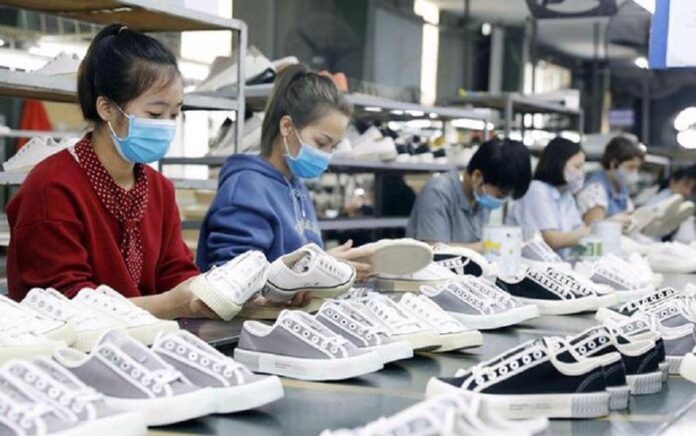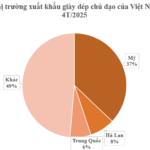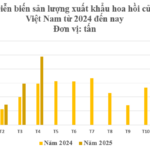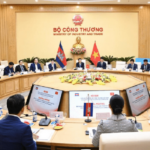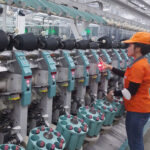With the global economy in a state of flux and ever-increasing challenges, Vietnam’s textile, apparel, and footwear industries are faced with the imperative to effectively leverage Free Trade Agreements (FTAs) to diversify export markets, reduce dependence on traditional markets, and enhance competitiveness through innovative production and sustainable supply chain development.
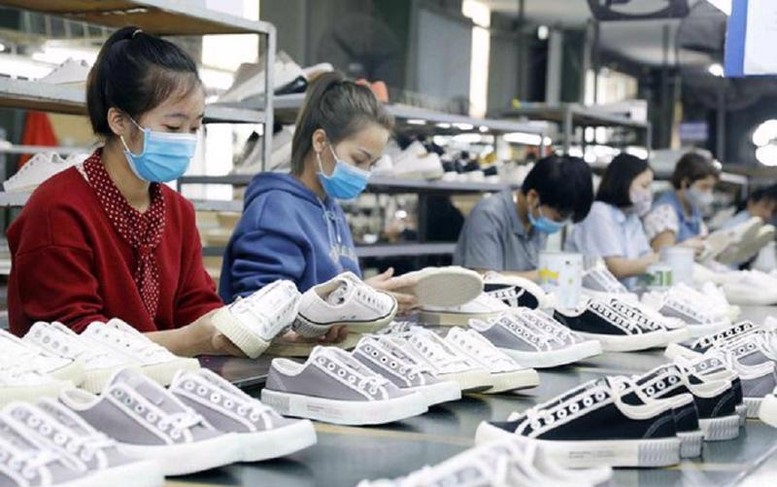
The footwear industry is currently grappling with significant challenges amidst global economic instability – Illustrative image
|
Phan Thi Thanh Xuan, Vice President and General Secretary of the Vietnam Leather, Footwear and Handbag Association, shed light on the myriad challenges confronting the footwear sector. These include global economic uncertainties, heightened risks from US tariff measures, and a substantial reliance on imported raw materials.
Additionally, escalating labor costs and non-tariff barriers, particularly stringent standards pertaining to green production, circularity, and CO₂ emission reduction imposed by the European Union, necessitate urgent adjustments in production processes towards sustainability. Furthermore, supply chain and logistics operations remain fraught with risks, impacting order fulfillment and trade transactions.
Confronted with these challenges, Ms. Xuan proposed a myriad of solutions to bolster trade promotion efforts effectively. The focal point is to augment support for businesses in market research and establish an export database to foster enhanced connections with international clients. Simultaneously, there is a pressing need to elevate the caliber of human resources, especially in the realms of marketing and product design, through collaborations with international experts.
International trade promotion endeavors must also be intensified within Vietnam via expositions, exhibitions, conferences, and trade delegations. Moreover, the trend toward digital transformation should be maximized by harnessing technologies such as online fairs, e-commerce platforms, AI, Big Data, and blockchain to enhance precision and efficacy in market penetration.
Ms. Xuan underscored the importance of attracting investments, particularly from foreign sources, into the production and distribution of raw materials and auxiliary materials. This initiative aims to establish domestic supply hubs and foster sustainable supply chains for the footwear industry.
Truong Van Cam, Vice President of the Vietnam Textile and Apparel Association (VITAS), revealed that the United States is currently the largest export market for Vietnam’s textile and apparel industry, accounting for over one-third of the total turnover in 2024. Meanwhile, the European market is tightening sustainability standards, forcing businesses to grapple with intense competition from formidable rivals such as China, India, Bangladesh, and Indonesia. More alarmingly, investment inflows into pivotal yet deficient sectors like fabric weaving and dyeing, which play a decisive role in fulfilling rules of origin for FTAs, exhibit a declining trend.
Amid these challenges, numerous businesses have proactively devised investment plans and joint ventures in the fabric sector to gradually attain self-sufficiency in raw materials and ensure transparent supply chains—a prerequisite for penetrating the US market and other premium markets. These endeavors are accompanied by restructuring efforts, technological advancements, and the vigorous application of e-commerce to optimize production and operational costs. Additionally, enterprises are vigorously seeking new markets to diminish dependence on their primary market.
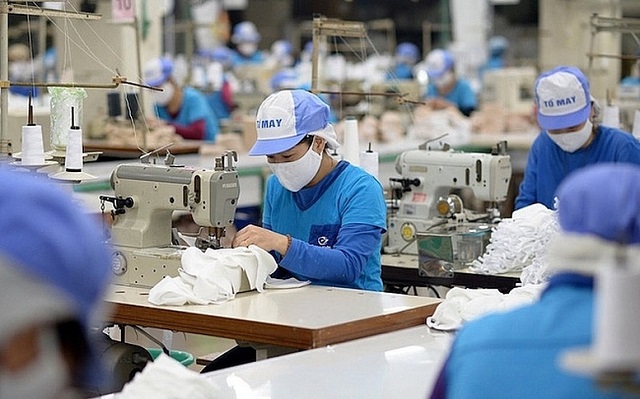
Despite challenges, many businesses have proactively invested and formed joint ventures in the fabric sector to gradually achieve self-sufficiency in raw materials – Illustrative image
|
Harnessing FTAs, Surmounting Hurdles
From a governmental management perspective, Ngo Chung Khanh, Deputy Director of the Department of Multilateral Trade Policy, emphasized five critical issues to consider regarding the textile, apparel, and footwear industries in the context of integration and FTA utilization.
Firstly, the matter of raw materials. Presently, origin criteria are more intricate than before. Consequently, enterprises need to strategize by balancing short-term and long-term benefits. Investing tens of millions of USD or collaborating with foreign investors to attract raw material supply chains to Vietnam is a viable option to consider. Without autonomous supply sources, we will encounter difficulties in fulfilling origin rules when accessing traditional markets, which previously had lenient raw material requirements.
Secondly, the issue of orders. Orders in the footwear and textile sectors fluctuate over time, but analysis reveals an excessive reliance on a singular market. The disparity in turnover between this market and the second-largest market is substantial, impeding the optimal utilization of FTAs. The root cause is not a lack of enterprise capability but rather an over-reliance on favorable existing conditions. However, amidst adversity, enterprises can venture beyond their comfort zone to uncover unprecedented opportunities.
Thirdly, the sluggish pace of FTA utilization. Vietnam’s competitive advantages in terms of tariffs vis-à-vis competitors like Thailand, Malaysia, and Indonesia in markets such as the EU, the UK, Canada, and Mexico are narrowing. This is because these markets are also vigorously diversifying their trade relations. Previously, negotiating FTAs with Malaysia, Thailand, or Indonesia was arduous, but now it can be accomplished within a year. Consequently, if we fail to seize these preferential opportunities promptly, our advantages will gradually dissipate.
Fourthly, the issue of supportive policies in credit and capital. This is essential yet lacks synchronization and effectiveness across all localities.
Fifthly, brand building. The strategy for the textile, apparel, and footwear industries envisions attaining regional-level brands by 2030, with a vision for 2035. To materialize this, substantial investments are imperative in brand identity, quality, value chains, and international promotion.
Addressing these five issues, Mr. Ngo Chung Khanh elaborated on three pillars that the Ministry of Industry and Trade is focusing on for resolution.
The first pillar pertains to the government’s establishment of the FTA Information Portal—a “single window” comprehensively providing information related to free trade agreements, encompassing commitments, guidelines, market analysis, and data. However, to function effectively, this portal necessitates close collaboration from industry associations, localities, and relevant ministries and sectors.
The second pillar involves a supportive mechanism, for which the Ministry of Industry and Trade has submitted a proposal, and the government has consented to implement an index evaluating the effectiveness of FTA implementation across localities. Ranking the provinces and cities is intended not only to spur local governments into proactive action but also to incentivize the deployment of more pragmatic central government policies. Reality has shown that the same policy can yield markedly different outcomes depending on the locality’s dynamism.
The third solution is a long-term and fundamental one, involving the establishment of an ecosystem comprising two components. The first is an inter-sectoral working group involving representatives from relevant ministries, sectors, and local governments. The second component pertains to enterprises operating according to market principles, acting as a link across the entire chain, from farmers, procurers, processors, and producers to credit institutions, logistics enterprises, localities, and ministries and sectors.
Notably, this ecosystem will also interconnect with Vietnamese trade offices abroad to directly connect with importers and distributors. When engaging with international partners, they expressed their welcome for this model. A tightly interconnected system between domestic and foreign entities will forge an overarching value chain, fostering mutual support, complementing strengths, and rectifying weaknesses, thereby effectively harnessing FTAs.
– 08:45 31/05/2025
The Elusive Money-Spinning Tree: India’s Hunt for Vietnam’s Billion-Dollar Blossom.
In April alone, exports of this commodity skyrocketed, witnessing a staggering 90% surge in revenue.
“Vietnam and Cambodia Unite to Boost Bilateral Trade to $20 Billion”
The two ministers, Nguyen Hong Dien and Cham Nimul, emphasized the significance of economic and trade cooperation, deeming it a pivotal aspect of strengthening ties between Vietnam and Cambodia. They agreed to set an ambitious target of increasing bilateral trade to 20 billion USD in the coming years.
The Export Edge: How Local Businesses Are Leading Southeast Asia’s Growth
As of late, the domestic business sector has been a shining star in our country’s export landscape, thanks to its vigorous efforts and remarkable growth.

